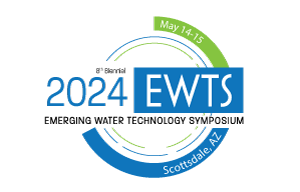Day 1
The Drama Over the U.S. Water Efficiency Standards
- Mary Ann Dickinson
Over its four years, the Trump Administration often publicly questioned the value and efficacy of federal water efficiency standards for toilets, showerheads, faucets, clothes washers and dishwashers. The US water efficiency community was understandably concerned about what might potentially happen. And indeed the Department of Energy (DOE) did issue final rules in 2020 which made controversial changes to showerheads, clothes washers and dishwashers. Product efficiency standards have been our proudest water and energy efficiency achievement in the US. This presentation will discuss the events that transpired in 2020 and what is in the horizon for change.
Environmental Monitoring for Assessing Risk From Legionella and Waterborne Pathogens in Building Water Systems : What's New?
- Janet E. Stout
How do you know and measure risk of Legionella and other waterborne bacterial pathogens in your water systems? The answer is simple—through routine monitoring. That’s why the Centers for Medicare and Medicaid Services (CMS), now requires long-term care facilities, hospitals, and critical access hospitals assess risk from the growth and spread of Legionella, Pseudomonas, Acinetobacter, Burkholderia, Stenotrophomonas, nontuberculous mycobacteria. The risk of illness from these microbes differs depending on the type of water system, building occupant health and the potential for exposure. What they share is the importance of including water testing as part of a risk assessment. With the ever-growing numbers of new test methods and approaches, selecting the right test can be confusing to see through the hype. When testing isn’t done correctly (accurately), risk could be underestimated or overestimated. How do you know what tests overpromises and underdelivers? Learn about the microbes in our water systems, role of testing, disease occurrence, sampling plans, and results interpretation. Learn how to keep yourself, building occupants and patients safer with routine monitoring that ensures accurate risk assessments and effective water management!
Moving Towards Predicting Building Water Safety: Plumbing Design, Use, and Disasters
- Andrew J. Whelton
This presentation will describe progress of a plumbing safety research initiative catalyzed in 2016 by a $2 million federal grant and partnerships with the health, technology, and government sectors. No fewer than 20 studies are being conducted by four leading Universities for this initiative. Lead institutions include Purdue University, Michigan State University, Tulane University, and University of Memphis. Studies are focused on plumbing safety in school, office, and residential buildings. Pathogen detection and contaminant exposures for Legionella, Mycobacteria, lead and copper, among other contaminants are also being investigated coupled with water use. Both municipal water and rainwater plumbing systems are being tested considering contaminant exposures and health risk assessments. Artificial intelligence coupled with online monitoring, in-building water treatment and plumbing decontamination solutions are being explored. Direct support to the health, technology, and government sectors. Education activities have been conducted for the health, technology, and utility sectors and for survivors of the 2018 Camp Fire. collaborations have been established with Chico State University, Butte College, and UC Berkeley, Northeastern University, and Drexel University.
Panel Discussion – Designing More Resilient Plumbing Systems
- Christoph Lohr Jonathan Leung Edwin Gonzalez
Due to more extreme weather events and climate change, building resiliency has become more important. However, the resiliency of plumbing systems is something that is unique from the general built environment. This panel will begin to discuss the concepts of plumbing resiliency, specifically in the realm of sustainability, water quality, and water safety. The conversation will continue by giving the perspective of the challenges that need to be overcome in providing high water quality in a sustainable way. One opportunity that will be discussed is how to utilize automated plumbing systems to provide better control and data of plumbing systems. Finally, the panel will have a conversation of sustainable water safety, and some opportunities in balancing these two criteria that often are seen to be competing.
Day 2
The Internet of Water: Enabling Competitions to Drive Behavioral Change
- Nina Kshetry
Competitions (or gamification) have been used to change population-level behavior in many areas such as consumer engagement, health and wellness, and education. Providing relevant real-time or near real-time behavioral data to consumers is needed to support competitions on social networks with behavioral change objectives and can even be enough, in and of itself, to drive change. With data becoming available through the emerging internet of water, we are now approaching a tipping point where water-focused competitions and peer-pressure social networks to drive behavioral changes are becoming a reality. Such tools have been successfully implemented and demonstrated in other areas of resource conservation in the environmental field. In this presentation, we will summarize the latest research on using real-time information, competitions, and peer pressure to drive behavioral changes in the environmental field, and highlight the opportunities afforded by the internet of water and its attendant wealth of water data.
The Water Demand Calculator Leaves Home
- Steve Buchberger
An IAPMO task group recently completed a six-year study on estimating peak water demands in residential buildings fitted with efficient fixtures. The IAPMO study introduced a new probability-based method, similar in principle to Hunter’s iconic curve, for determining peak indoor water demands. The new method is now part of Appendix M in the 2018 UPC. In a key departure from current practice, the new method replaces Hunter’s fixture units with the probability of fixture use. Fixture use probabilities were estimated from a data base of nearly 865,000 indoor water use measurements taken at 1,038 single family homes in 62 cities across the nation. The new method for estimating peak water demands was coded into an EXCEL spreadsheet, called the Water Demand Calculator (WDC), available on-line from IAPMO and also as a smart phone application. The WDC can be applied to a broad spectrum of premise plumbing scenarios, ranging from flows feeding a single fixture at an individual home to peak flows through service lines supplying large residential developments. In this talk, the assumptions and advantages implicit in the WDC will be examined. The performance of the WDC will be critically evaluated using comparisons of peak flow predictions against actual water demand measurements at a several residential and non-residential locations across the US. Recent progress in extending the WDC framework beyond the residential sector to commercial buildings and public institutions will be discussed.
Water from Air: Pipe Dream or Resilient Complement to Premise Plumbing Systems
- Chris Kay
With more water in the atmosphere than in all the rivers on the planet, it's a tragedy 1 in 2 people will experience water scarcity due to contamination or drought by 2025. This presentation will discuss the evolution in water-from-air technology that can augment existing drinking water resources with pure water from the air, even in the desert. See Mojave Desert example: http://bit.ly/WH_UC
Identifying Key Research Needs for Premise Plumbing
- Dr. William Healy
The premise plumbing industry faces challenges in meeting ever-increasing water efficiency, energy efficiency, and water quality goals. Yet, much of the underlying science behind standards, codes, and guidance for design and maintenance dates to the early 20th century. To identify key research needs to assist the industry in developing and maintaining modern premise plumbing systems, the National Institute of Standards and Technology has embarked on an effort to develop a research roadmap for the premise plumbing industry. This report identifies fundamental science needed to better understand and characterize water delivery and waste conveyance as well as tools needed by designers and engineers to ensure safe and efficient premise plumbing systems. The purpose of this presentation is to share the results of this effort to (a) assist researchers in planning projects, (b) provide funding organizations background on the key needs of the industry, and (c) guide the development of technologies that can meet the goals of premise plumbing.
Panel Discussion – Premise Plumbing Research and Implementation – What’s Next?
- Andrew K. Persily Dr. William Healy Dr. Grace Jang Regan Murray Steve Buchberger Dan Cole
The field of premise plumbing research, and the motivations for generating new knowledge, have been evolving for several years. This panel will discuss recent trends impacting current and future premise plumbing system performance and the most important research efforts needed to improve system performance. A range of current research efforts will be noted, with the goal of identifying strategies to facilitate connections between researchers and those using the research results. Finally, the panel will discuss actions to implement new research results, including design methods, practitioner guidance, standards and codes.














